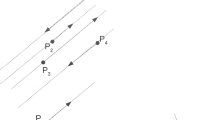Abstract
Singularity analysis is an important subject of the geometric constraint satisfaction problem. In this paper, three kinds of singularities are described and corresponding identification methods are presented for both under-constrained systems and over-constrained systems. Another special but common singularity for under-constrained geometric systems, pseudo-singularity, is analyzed. Pseudo-singularity is caused by a variety of constraint matching of under-constrained systems and can be removed by improving constraint distribution. To avoid pseudo-singularity and decide redundant constraints adaptively, a diferentiation algorithm is proposed in the paper. Its correctness and efficiency have been validated through its practical applications in a 2D/3D geometric constraint solver CBA.
Similar content being viewed by others
Explore related subjects
Discover the latest articles, news and stories from top researchers in related subjects.References
Light R, Lin V, Gossard D. Variational geometry in CAD.Computer Graphics, 1981, 15 (3): 171–177.
Kramer G A. A geometric constraint engine.Artificial Intelligence, 1992, 58: 327–360.
Chen Liping, Zhou Ji. Research of geometric constraint system reasoning.Journal of Huazhong Univ. of Sci & Tech, 1995, 6: 70–74. (in Chinese)
Dong Jinxiang. A new thought of constraint solving in variable drawing systems.Journal of Computer-Aided Design & Computer Graphics, 1997, 9(6): 513–519. (in Chinese)
Jae Yael Lee, Kwangsoo Kim. A 2-D geometric constraint solver using DOF-based graph reduction.Computer-Aided Design, 1998, 30(11): 883–896.
Gao Xiaoshan, Chou Shangching. Solving geometric constraint systems. Part II, A symbolic approach and decision of Re-constructibility.Computer-Aided Design, 1998, 30(20): 115–122.
Wang Boxing, Chen Liping, Zhou Ji. Study and practice of key technologies of geometric constraint driven function in traditional drafting systems.Computer Research & Development, 1998, 35(10): 935–940. (in Chinese)
Chen Liping, Wang Boxing. An optimal method of bipartite graph matching for underconstrained geometry solving.Chinese Journal of Computers, May, 2000, 23(5): 523–530. (in Chinese).
Haug E J. Computer Aided Kinematics and Dynamics of Mechanical Systems. Allyn and Bacon, Vol.I, 1989.
Hong Jiazhen. Computational Dynamics of Multibody Systems. Advanced Education Press, China, 1996, (4): 70. (in Chinese)
Chen Liping, Peng Xiaobo. An approach to a 2D/3D geometric constraint solver. InProceedings of ASME DETC'00/DAC-14515, Baltimore, Maryland, September 10–13, 2000.
Yan Weimin, Wu Weiming. Data Structure. Tsinghua University Press, China, 1992. (in Chinese)
Author information
Authors and Affiliations
Corresponding author
Additional information
This research is partly supported by the National ‘863’ High-Tech Programme of China under grant No.9842-003.
PENG Xiaobo received his B.S. and M.S. degrees from Huazhong University of Science and Technology, Wuhan, in 1995 and 1998 respectively. Now he is a Ph.D. candidate in the National CAD Support Software Engineering Research Center, Huazhong University of Science & Technology. He specializes in geometric constraint solving, solid modeling and design automation. His current research activities focus on the research of key technologies of 3D variable geometry, whose primary goal is to provide an effective geometric constraint solver for 2D/3D CAD system applications.
CHEN Liping received his Ph.D. degree from Huazhong University of Science and Technology, Wuhan, in 1995. He is currently a professor in the National CAD Support Software Engineering Research Center, Huazhong University of Science & Technology. His research interests are in the areas of geometric constraint solving, kinematics and dynamics, feature-based and dimension-driven solid modeling and CAD/CAM integration.
ZHOU Fanli is a Ph.D. candidate in the National CAD Support Software Engineering Research Center, Huazhong University of Science & Technology, Wuhan. His research interests include kinematics, dynamics and stimulation.
ZHOU Ji received his Ph.D. degree from the State University of New York at Buffalo in 1984. He is a member of Chinese Academy of Engineering and a professor at Huazhong University of Science & Technology, Wuhan. His research interests focus on CAD/CAM systems, geometric modeling, optimization and intelligent design.
Rights and permissions
About this article
Cite this article
Peng, X., Chen, L., Zhou, F. et al. Singularity analysis of geometric constraint systems. J. of Comput. Sci. & Technol. 17, 314–323 (2002). https://doi.org/10.1007/BF02947309
Received:
Revised:
Issue Date:
DOI: https://doi.org/10.1007/BF02947309




